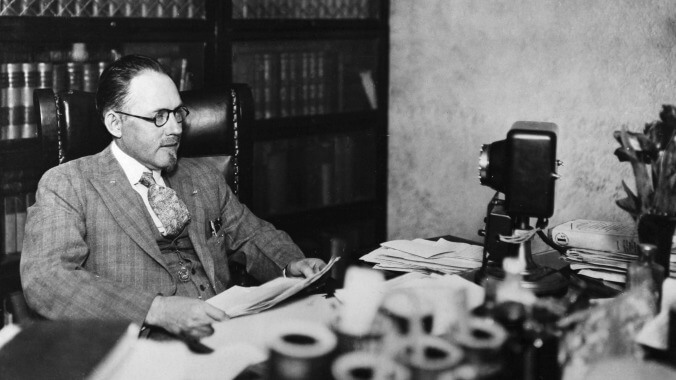Burnett died of tuberculosis when her son was 5, so he was raised by his great-aunt/stepmother thereafter. When she died in 1906, 21-year-old Brinkley was consoled by a former classmate, Sally Wike. They married a month later, moved to Chicago, and Wike gave birth to a daughter 10 months after that. Brinkley worked his way through an unaccredited med school with “questionable curricula” by working at Western Union, but debts piled up between tuition, their daughter, and “Sally’s self-centered whims.” Despite Brinkley working double shifts to try and keep the family afloat, his wife left and filed for divorce. But after two months of making child support payments, Brinkley kidnapped his daughter and fled to Canada, but returned to Chicago after Sally let him off the hook for alimony and child support, and the two improbably reconciled. She left him again in 1911, moving back to North Carolina, and had a second daughter that same year (the order of events isn’t clear). This time he followed her, leaving behind a stack of unpaid tuition bills. Reconciled a third time, the couple had a third daughter in 1913 and moved to New York, then back to Chicago. When Brinkley refused to give up his dream of being a questionably credentialed doctor, Sally left for the final time.
They next went to Crawford’s hometown of Memphis, where Brinkley met 21-year-old Minerva Jones and married her four days later, despite still being married to his first wife. After more bouncing around between towns, jobs, and shady colleges, he ended up in Kansas City, working as the in-house doctor at a slaughterhouse. The staff believed the goat to be the healthiest animal that came through the plant, which Brinkley took note of.
After a two-month stint in the Army during World War I, and a discharge after a nervous breakdown, Brinkley opened a clinic in Milford, Kansas. He won over the town by paying good wages to his staff and making house calls to those stricken in the 1918 flu pandemic. (It seems to be the one time in his career he was legitimately caring and helpful to his patients.) But when a man came to him complaining of being “sexually weak,” Brinkley was immediately back to his old tricks. Remembering those healthy goats from the slaughterhouse, he offered to implant a pair of goat testicles within the man’s original pair, and the man surprisingly agreed, as did a string of other patients (paying nearly $10,000 in today’s money for the privilege). As the goat testes were simply placed loosely into the scrotum, they had no effect and were generally broken down by the body. But the surgery wasn’t always so harmless—through the 1930s, Brinkley would be sued for wrongful death over a dozen times, which Wikipedia attributes to Brinkley’s lack of real medical training, non-sterile surgical environments, and “frequency of operating while intoxicated.”
Thing we were happiest to learn: While Brinkley wasn’t much of a doctor, he was a legitimate pioneer in radio. In 1923, he launched KFKB, largely to promote his clinic, although in between ads he played roots music, Hawaiian folk songs, gospel, country, French lessons, astrology, and storytelling. However, the Kansas City Star owned a rival radio station, and the newspaper began reporting on Brinkley’s questionable medical practices. In 1930, the state revoked his medical license, and the following year, FCC precursor the Federal Radio Commission revoked his broadcast license, finding that his broadcasts were “mostly advertising,” in violation of his license. He ran for governor of Kansas, hoping to stack the medical board with friendly faces who would restore his medical license. When he lost a close three-way race (Wikipedia speculates that 30,000 to 50,000 write-in ballots, which were disqualified for questionable reasons, would have tipped the election in his favor), he turned his attention back to radio.
The Mexican government was upset that the U.S. and Canada had divided up radio frequencies without giving any consideration to their southern neighbor. So they granted licenses for “border blaster” stations, with powerful transmitters that pointed north, interference with American stations be damned. Brinkley snapped up a 50,000-watt license and built XER, a station that broadcast from Mexico but could be heard in Kansas. In 1932, Mexico allowed him to increase his wattage to 150,000, then a million. (Fifty thousand was the legal limit in the U.S.) The signal was so strong that it interfered with phone calls, and ranchers near the transmitter claimed their metal fences and dental appliances reverberated with the station’s signal. The station advertised such questionable products as “Crazy Water Crystals” and autographed pictures of Jesus Christ. But it also helped launch the careers of the Carter Family, Jimmie Rodgers, and Gene Autry by giving them airplay across North America.
Brinkley still lived in Kansas, literally phoning in his radio broadcasts, until Congress outlawed the practice in 1932. (The law is actually called the Brinkley Act.) Instead, he essentially invented pre-recorded shows, sending “electrical transcriptions” to Mexico to be broadcast.
Thing we were unhappiest to learn: While we shouldn’t be that unhappy that a fraud and con artist got his comeuppance, we still can’t help feel a little sympathy for how quickly everything fell apart for Brinkley. In 1938, the Journal Of The American Medical Association published an exposé of Brinkley called “Modern Medical Charlatans,” which was the beginning of his downfall. Brinkley sued the journal for libel and lost the suit, as the jury declared him “a charlatan and a quack in the ordinary, well-understood meaning of those words.” Now exposed as a fraud, countless lawsuits against Brinkley followed, and the IRS piled on, too, investigating Brinkley for tax fraud, as the U.S. Post Office also investigated him for mail fraud. Brinkley declared bankruptcy in 1941, the same year Mexico signed a radio bandwidth agreement with the U.S. that involved shutting down XER. At some point during all this, Brinkley also had three heart attacks and a leg amputated due to poor circulation. He died in 1942, penniless, with his mail fraud trial still pending.
Also noteworthy: For those of you asking how no one’s made Brinkley’s life story into a movie yet, 2016 documentary Nuts! did just that (using animation to re-create scenes from his life). The Reply All podcast also did an episode on Brinkley, and Richard Linklater is now planning a film based on Brinkley’s life by way of the podcast story, with Robert Downey Jr. lined up to star (although The A.V. Club reported on that casting notice back in 2017, so who knows if the movie will ever come to pass).
Further down the Wormhole: While he never lived there, Brinkley was dazzled by a visit to Los Angeles, planning to relocate his clinic there until the California medical board denied him a license (it found his résumé to be “riddled with lies and discrepancies”). Having missed out on his chance to become the City Of Angels’ preeminent huckster, that title instead fell to the Church Of Scientology, a moneymaking scam disguised as a not-terribly-convincing religion made up by science fiction writer L. Ron Hubbard. One of Hubbard’s early supporters was fellow pulp writer John W. Campbell, whose later career was marked by a turn toward belief in all manner of pseudoscience, including ESP and telepathy, Scientology, and the Dean drive, a machine that supposedly created energy in violation of Newton’s third law. We’ll see if anyone got away with breaking the laws of physics next week.








































